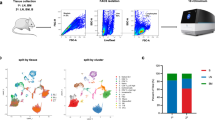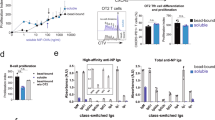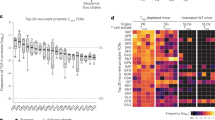Abstract
Resting T lymphocytes may be activated either physiologically, by the specific recognition of antigen in association with molecules encoded by the major histocompatibility complex (MHC), or non-physiologically using mitogens such as concanavalin A (Con A). The former activation process is difficult to analyse because resting precursor T cells specific for a particular antigen–MHC combination can only be isolated in the presence of a large excess of bystander cells of irrelevant specificity; clonal populations of uniform specificity are not useful for studying the activation of naive T cells because there is no reason to believe that such cloned cells ever return to the state of resting precursors. Mitogens may activate a large fraction of resting T cells, but analysis is again complicated because the target molecule(s) of most mitogens is unknown and the relationship of this kind of activation to physiological induction by antigen plus MHC molecules remains unclear. By using a monoclonal antibody specific for the antigen receptors on ∼25% of all T cells of both Lyt 2+ and Lyt 2− subsets, we have studied the induction of lymphokine responsiveness in resting normal T cells. This antibody, immobilized on Sepharose beads, is sufficient to activate Lyt 2+ T cells, but not Lyt 2− T cells, to clonal expansion in the presence of a mixture of lymphokines (10% rat spleen Con A supernatant). We report here that clonal growth of the T cells obeys single-hit kinetics in limiting-dilution microcultures, suggesting that a single cell type is limiting. We conclude that cytotoxic T-lymphocyte (Tc) precursors require only ligation of the antigen receptor before they become responsive to lymphokines, whereas helper T-lymphocyte (Th) precursors require additional signals.
This is a preview of subscription content, access via your institution
Access options
Subscribe to this journal
Receive 51 print issues and online access
$199.00 per year
only $3.90 per issue
Buy this article
- Purchase on Springer Link
- Instant access to full article PDF
Prices may be subject to local taxes which are calculated during checkout
Similar content being viewed by others
References
Staerz, U. D., Rammensee, H.-G., Benedetto, J. & Bevan, M. J. J. Immun. 134, 3994–4000 (1985).
Roehm, N. et al. Cell 38, 577–584 (1984).
Chien, Y.-L. et al. Nature 312, 31–35 (1984).
Lefkovits, I. & Waldmann, H. Limiting Dilution Analysis of Cells of the Immune System (Cambridge University Press, 1979).
Gullberg, M. et al. Eur. J. Immun. 13, 719–725 (1983).
Malek, T. R., Schmidt, J. A. & Shevach, E. M. J. Immun. 134, 2405–2413 (1985).
Erard, F. et al. J. Immun. 134, 1644–1652 (1985).
O'Flynn, K. et al. Nature 313, 686–687 (1985).
Bruce, J., Symington, F. W., McKearn, T. J. & Sprent, J. J. Immun. 127, 2496–2501 (1981).
Raulet, D. H., Gottlieb, P. D. & Bevan, M. J. J. Immun. 125, 1136–1143 (1980).
Dialynas, D. P. et al. Immun. Rev. 74, 29–56 (1983).
Ledbetter, J. A. & Herzenberg, L. A. Immun. Rev. 47, 63–90 (1979).
Wysocki, L. J. & Sato, V. L. Proc. natn. Acad. Sci. U.S.A. 75, 2844–2848 (1978).
Sarmiento, M., Glasebrook, A. L. & Fitch, F. W. J. Immun. 125, 2665–2672 (1980).
Author information
Authors and Affiliations
Rights and permissions
About this article
Cite this article
Crispe, I., Bevan, M. & Staerz, U. Selective activation of Lyt 2+ precursor T cells by ligation of the antigen receptor. Nature 317, 627–629 (1985). https://doi.org/10.1038/317627a0
Received:
Accepted:
Issue Date:
DOI: https://doi.org/10.1038/317627a0
This article is cited by
-
Positive selection of T lymphocytes on fibroblasts
Nature (1993)
-
lnterleukin-2 programs mouse αβ T lymphocytes for apoptosis
Nature (1991)
-
T-cell tolerance by clonal anergy in transgenic mice with nonlymphoid expression of MHC class II I–E
Nature (1989)
-
A novel population of T-cell receptor αβ-bearing thymocytes which predominantly expresses a single Vβ gene family
Nature (1987)
-
Expression of L3T4 molecules on Lyt-2+, class II-restricted antigen-specific T suppressor lymphocytes
Immunogenetics (1986)
Comments
By submitting a comment you agree to abide by our Terms and Community Guidelines. If you find something abusive or that does not comply with our terms or guidelines please flag it as inappropriate.



